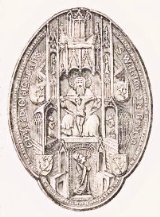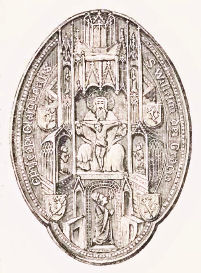
William de Lawedre
Encyclopedia

Lord Chancellor of Scotland
The Lord Chancellor of Scotland was a Great Officer of State in pre-Union Scotland.Holders of the office are known from 1123 onwards, but its duties were occasionally performed by an official of lower status with the title of Keeper of the Great Seal...
.
The son of Sir Robert de Lawedre of Edrington
Robert de Lawedre of Edrington
Sir Robert de Lawedre of Edrington & The Bass, Knt., was a Burgess of Edinburgh and a confidant of King Robert III and sometime Guardian of his son, the future James I of Scotland.-Family:...
, and The Bass, by his spouse Annabella, William was uterine brother (i.e. shared his mother) to Alexander de Lawedre, bishop of Dunkeld
Bishop of Dunkeld
The Bishop of Dunkeld is the ecclesiastical head of the Diocese of Dunkeld, one of the largest and more important of Scotland's 13 medieval bishoprics, whose first recorded bishop is an early 12th century cleric named Cormac...
.
William Lauder held a Doctorate in Canon Law was educated at the University of Paris
University of Paris
The University of Paris was a university located in Paris, France and one of the earliest to be established in Europe. It was founded in the mid 12th century, and officially recognized as a university probably between 1160 and 1250...
were he took a great interest in its affairs and eventually became Rector. In 1392, while still at university, he was given the parish church of St. Eligius, a benefice in the gift of the Bishop, dean and chapter of St. Malo. He also appears on the Roll of the University of Angers
University of Angers
The University of Angers is an institution of higher learning situated in the town of the same name, in western France. It was founded in 1356, closed down in 1793, and reestablished in 1971....
where he spent some time studying and lecturing.
Before 1404, William Lauder had the Archdeaconry of Lothian
Archdeaconry of Lothian
The Archdeaconry of Lothian, located in modern-day Scotland, was a sub-division of the diocese of St Andrews, one of two archdeaconries within the diocese. The Lothian archdeaconry was headed by the Archdeacon of Lothian, a subordinate of the Bishop of St Andrews. In the medieval period, the...
conferred on him by Bishop Wardlaw of St.Andrews, as well as holding a canonry and prebend in Moray. In 1405 Lauder unsuccessfully sued in the Curia for the Precentorship of Glasgow. "Willielmus de Lawadir, Archdeacon of Lothian, accompanied by Alanus de Lawedir de Scotia" (his brother) had a safe-conduct from King Henry IV
Henry IV of England
Henry IV was King of England and Lord of Ireland . He was the ninth King of England of the House of Plantagenet and also asserted his grandfather's claim to the title King of France. He was born at Bolingbroke Castle in Lincolnshire, hence his other name, Henry Bolingbroke...
dated 18 September 1404 with another the following year.
He was 'preferred' and appointed to the bishopric of Glasgow by Avignon Pope Benedict XIII on July 9, 1408, and not by election of the Chapter. The Chapter did not challenge his selection, however, and Bishop Dowden suggests that he went to Avignon
Avignon
Avignon is a French commune in southeastern France in the départment of the Vaucluse bordered by the left bank of the Rhône river. Of the 94,787 inhabitants of the city on 1 January 2010, 12 000 live in the ancient town centre surrounded by its medieval ramparts.Often referred to as the...
to receive consecration
Consecration
Consecration is the solemn dedication to a special purpose or service, usually religious. The word "consecration" literally means "to associate with the sacred". Persons, places, or things can be consecrated, and the term is used in various ways by different groups...
, returning after Martinmas the same year. This seems to be supported by an indult
Indult
An indult in Catholic canon law is a permission, or privilege, granted by the competent church authority – the Holy See or the diocesan bishop, as the case may be – for an exception from a particular norm of church law in an individual case, for example, members of the consecrated life seeking to...
dated 11 July 1408 for him to be consecrated elsewhere, and it is likely that occurred in France. On the 24th October, King Henry IV of England
Henry IV of England
Henry IV was King of England and Lord of Ireland . He was the ninth King of England of the House of Plantagenet and also asserted his grandfather's claim to the title King of France. He was born at Bolingbroke Castle in Lincolnshire, hence his other name, Henry Bolingbroke...
granted "William de Lawedre, Bishop of Glasgow" safe conduct to pass through the Kingdom of England
Kingdom of England
The Kingdom of England was, from 927 to 1707, a sovereign state to the northwest of continental Europe. At its height, the Kingdom of England spanned the southern two-thirds of the island of Great Britain and several smaller outlying islands; what today comprises the legal jurisdiction of England...
to the Kingdom of France
Kingdom of France
The Kingdom of France was one of the most powerful states to exist in Europe during the second millennium.It originated from the Western portion of the Frankish empire, and consolidated significant power and influence over the next thousand years. Louis XIV, also known as the Sun King, developed a...
.
Bishop William was deeply involved in the affairs of the kingdom. In 1406 he was one of the commissioners sent to Charles, King of France, in order to renew the alliance with France against the English. He attended the General Council at Perth
Perth, Scotland
Perth is a town and former city and royal burgh in central Scotland. Located on the banks of the River Tay, it is the administrative centre of Perth and Kinross council area and the historic county town of Perthshire...
in 1415, and from September 1420 until his death four years later, William was Lord Chancellor of Scotland
Lord Chancellor of Scotland
The Lord Chancellor of Scotland was a Great Officer of State in pre-Union Scotland.Holders of the office are known from 1123 onwards, but its duties were occasionally performed by an official of lower status with the title of Keeper of the Great Seal...
. On the 9 August 1423 he was named First Commissioner to treat with England for the ransom of James I
James I of Scotland
James I, King of Scots , was the son of Robert III and Annabella Drummond. He was probably born in late July 1394 in Dunfermline as youngest of three sons...
, which was accomplished during the following years. Another of the Commissioners was Sir Robert Lauder of Edrington, the Bishop's brother.
Bishop Lauder spent a great deal of his time continuing to build Glasgow or St Mungo's Cathedral building several portions of it, notably the crypt under the chapter house where the Lauder Arms were carved in several places. He also added the stone steeple and battlement to the already built tower and placed his arms, with a cherub for a crest, on the centre panel of the western parapet.
He was interred in the ancient (now gone) parish church of St. Mary, at Lauder
Lauder
The Royal Burgh of Lauder is a town in the Scottish Borders 27 miles south east of Edinburgh. It is also a royal burgh in the county of Berwickshire. It lies on the edge of the Lammermuir Hills, on the Southern Upland Way.-Medieval history:...
, Berwickshire
Berwickshire
Berwickshire or the County of Berwick is a registration county, a committee area of the Scottish Borders Council, and a lieutenancy area of Scotland, on the border with England. The town after which it is named—Berwick-upon-Tweed—was lost by Scotland to England in 1482...
, and succeeded by John Cameron
John Cameron (bishop)
John Cameron was a 15th century Scottish cleric, bishop of Glasgow, and Keeper of the Privy Seal.A licentiate in decrees , and provost of Lincluden, he became an official of the bishopric of St Andrews, and a canon of Glasgow, as well as secretary to Archibald Douglas, Earl of Wigtown, who...
.

